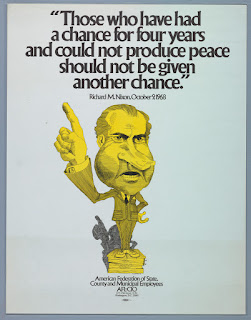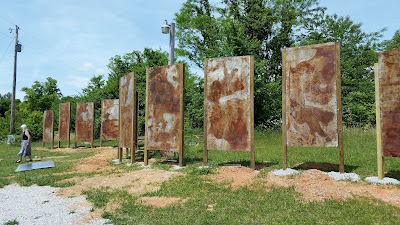Who are the Nationals?
The Washington Nationals are going to the World Series! The
sports commentators, looking for superlatives and hype, state that it’s the
first World Series in the franchise’s 50-year history! And the first time a
World Series has been played in the nation’s capital since 1933! The interested
listener might ask how that adds up, since 1933 was 86 years ago, and 50 years
ago was 1969.
The answer is that from 1969 to 2004, this team was the
Montreal Expos. In 2005, they moved to DC and became the Washington Nationals.
Meanwhile, the 1933 World Series in DC was the Washington Senators losing to
the New York Giants (before they moved to San Francisco) in five games.
If you’re not a DC baseball fan, you likely have no idea about this.
I grew up in Washington, DC, a fan of those Senators, but
decades after that World Series. The Senators were an American League (AL) team from
1901 to 1971. They won the World Series once, in 1924 (over the Giants), behind
pitcher Walter “Big Train” Johnson (23-7) and hitter Goose Goslin (both
Hall-of-Famers). Johnson had a 21-year career with 417 wins to 279 losses, a
lifetime 2.17 ERA, and the all-time record for career shutouts (110).
For 33 years, there was no major league baseball team in DC.
When the ex-Expos arrived in 2005, they had to play in RFK Stadium, the old
“big bowl” stadium of the Senators (from 1961-71) and NFL Redskins (from 1961-1996).
The nice new Nationals Park opened three years later.
I Thought Franchises were for Fast Food?
So, let me rant about the so-called baseball “franchise.”
The Senators team that left after 1971 was a different franchise than the 1901
team. In 1961, they moved to Minnesota, and a new "expansion" team started in DC.
Then in 1972, those Senators moved to Texas. After 33 years, the Expos move to
DC. A diagram might help:
1901-1960 Washington Senators >
1961-now Minnesota Twins
1961-1971 Washington Senators > 1972-now Texas Rangers
1969-2004 Montreal Expos > 2005-now
Washington Nationals
Hence, Walter Johnson and Goose Gosling are listed on the
Twins franchise history,
while my childhood baseball heroes are listed as Rangers. To me, the sports
commentators should say: it’s the first time in the Washington Nationals’
15-year history that they have gone to a World Series. It will be the fourth
time a DC team has gone to the World Series since 1901, and the first time
since 1933.
The Nationals name was used by a couple of different baseball
teams in DC in the late 1800s, but that’s too deep in the weeds even for me. The
game was in its infancy. For example, a “walk” or “base on balls” gradually
reduced from nine called “balls” to the current four between 1879 and 1889.
Damn Yankees
In Damn Yankees, the 1955 Broadway musical and
1958 movie, the inept Washington Senators contest the NY Yankees for the
pennant in an update of Faust. If I recall correctly, My Favorite
Martian tempts Tab, a hapless Senators fan into becoming a great player in
exchange for his soul, bringing them to the brink of success. Lola (not the one
from the Kinks song), figures into this somehow. Between 1955 and 1958, the real
Yankees won all four AL pennants, and two of those World Series. Meanwhile, the
real Senators were 8th or 7th (out of 8) each year. So,
it would take a deal with the devil to make a pennant race happen. Too bad the
Yankees didn’t make it to the World Series this year.
Even back in 1904, sportswriter Charles Dryden wrote of the
Senators, “First in war, first in peace, and last in the American League”
(mirroring a George Washington eulogy: “first in war, first in peace, and first
in the hearts of his countrymen”).
My Team
My dad took me to some Senators baseball games between 1969
and 1971. I have baseball cards and other souvenirs, including a bat from Bat
Day, a Senators glove, a baseball signed by three players, signed photos, and
scorecards.
 |
| Baseball bat "compliments of" the Washington Senators, and a glove, which I don't remember as being a giveaway. And, yes, we did use that bat to play baseball. (Photo by Kier Strejcek) |
In 1969, the Senators had their best year of my DC
residency. Ted Williams became Manager that year and was voted AL Manager of the Year. The team went from 65 wins in
1968 up to 86 wins, but the AL was dominated by the Orioles (109 wins)
that year, who would lose the World Series to the “Miracle” NY Mets, as many
Cubs fans are aware.
Ted Williams, you may already know, is the last player to
have hit .400 in a season (.406 in 1941). He also has the all-time best career
on-base percentage (OBP) of .482. He got on base nearly half the time. He
walked instead of striking out (averaging 143 walks to 50 strikeouts), and
still hit 521 home runs.
In his first year as manager, his legacy and tutelage did
have an effect on the players. Frank Howard, the team slugger, improved –
here’s a chart:
Year HR BB SO AVG OBP SLG OPS
1968 44 54 141 .274 .338 .552 .890
1969 48 102 96 .296 .402 .574 .976
I include the more arcane stats for the stat fans. Suffice it
to say, Howard improved in each category. He wasn’t a rookie, but in his 11th year. Williams was asked how he turned around Howard’s numbers (especially
walks and strikeouts). Ted said he just asked Frank to “take” the occasional
pitch (that is, don’t swing). Howard laughed at that, saying that Williams
worked with him more than that. Many other players improved their batting
numbers too. (See Washington's Expansion Senators (1961-1971), by James R. Hartley, for details.)
But it would not last. Next year, though Frank Howard still
excelled, the team was losing again, and by 1971, they had 63 wins and 96
losses. Many blamed the owner Bob Short, or some bad trades. In September of
1971, with seven games remaining, Short got American League approval to move
the team to Texas.
The Last Day
Meanwhile, I was 11 and in the Boy Scouts. My troop had
tickets to see the last game of the season. I don’t think we knew it would be
the last game ever when the group outing was planned. But go to the game we did,
the night of September 30, 1971.
At the stadium, we found out that there was a giveaway:
paperback copies of Ted Williams’ My Turn at Bat, his life story. Williams, by
the way, had enlisted in World War II, losing three years of his prime playing
time, and again in Korea, losing almost two more.
Our seats were in the right field
upper deck. We were playing the Yankees, who were mediocre that year (82-80).
The Yankees scored 2 runs in first inning, and again in the second. In the
third inning, the fans began to get rowdy. A "Short Stinks" banner
unfurled in third inning, and security removed it. (I think I saw a “Sh*t on
Short” banner, but no one else reported seeing it.) Later, Short was hung in
effigy from the upper deck opposite us. By the middle of sixth inning, the
Yankees were winning 5-1.
But Frank Howard leads off the bottom of the 6th inning with a home run. The fans go wild, giving him a standing ovation until
he takes a curtain call. The fans continue until a second curtain call, when he
tosses his batting helmet into the stands. The Senators rally for three more
runs in the inning, to tie it 5-5. Maybe we can win this, and finish on a high
note!
In the 7th inning, the crowd starts a chant of
"We want Short!" After Frank Howard fouls out, fans start ripping up
the paperback My Turn at Bat books for confetti, raining it down on the field. I’m sure our scoutmaster
tried to prevent us from joining in. Before the 8th inning, some
fans tried to run the bases but were chased off before the teams took the
field.
In the bottom of the 8th, the Senators score two runs on Yankee
errors. Before the 9th begins, there is more chanting. More fans run
on the field, and then the forfeit warning is announced over the PA. If order
is not restored, Washington will lose the game.
With two outs in the 9th inning, pandemonium
breaks out. I will let Shirley Povich, Washington Post sports writer at
the time, finish the story of “The Senators' Final Game”:
It got as far as two out in the
ninth, the Senators' 7-5 lead intact, no Yankee on base, when one young rebel
from the stands set off again. He grabbed first base and ran off with it. Some
unbelievers, undaunted by the warning of forfeit, cheered, and from out of the
stands poured hundreds, maybe a couple of thousand fans. They took over the
infield, the outfield, grabbed off every base as a souvenir, tried to get the
numbers and lights from the scoreboard or anything else removable, and by their
numbers left police and the four umpires helpless to intervene.
And so, the Senators, ahead 7-5, forfeited to the Yankees on
the final game of the season. Alas, it was a meaningless game for both teams.
Neither were anywhere near the AL pennant race.
Coda
I moved to the Chicago area to go to college, and after
several years of ignoring baseball, got invited to a Cubs game at Wrigley
Field. I had no idea that a baseball stadium could be so green, so well-proportioned,
with so many good seats. In fact, for years, I believed there were no bad seats
– until they decided to hang luxury boxes from the upper deck, thus blocking
some lower deck seats from seeing the scoreboard.
In the absence of a DC team, my brother Nathan, still there,
followed the Reds. We were both born in Ohio, so that made sense. In 2004, we
met in Cincinnati to watch the Cubs visit, watching three games, of which the
Cubs won two. In May of the next year, I went to DC to watch the Cubs play the new Washington Nationals at RFK with my brother. I missed the Friday night Cubs victory but got to
see the Nationals win twice over the next two days. The Nationals finished
their first season 81-81.
Now, the Nationals are the World Series underdog by a wide
margin. I’m rooting
for them. Go Nats!





































